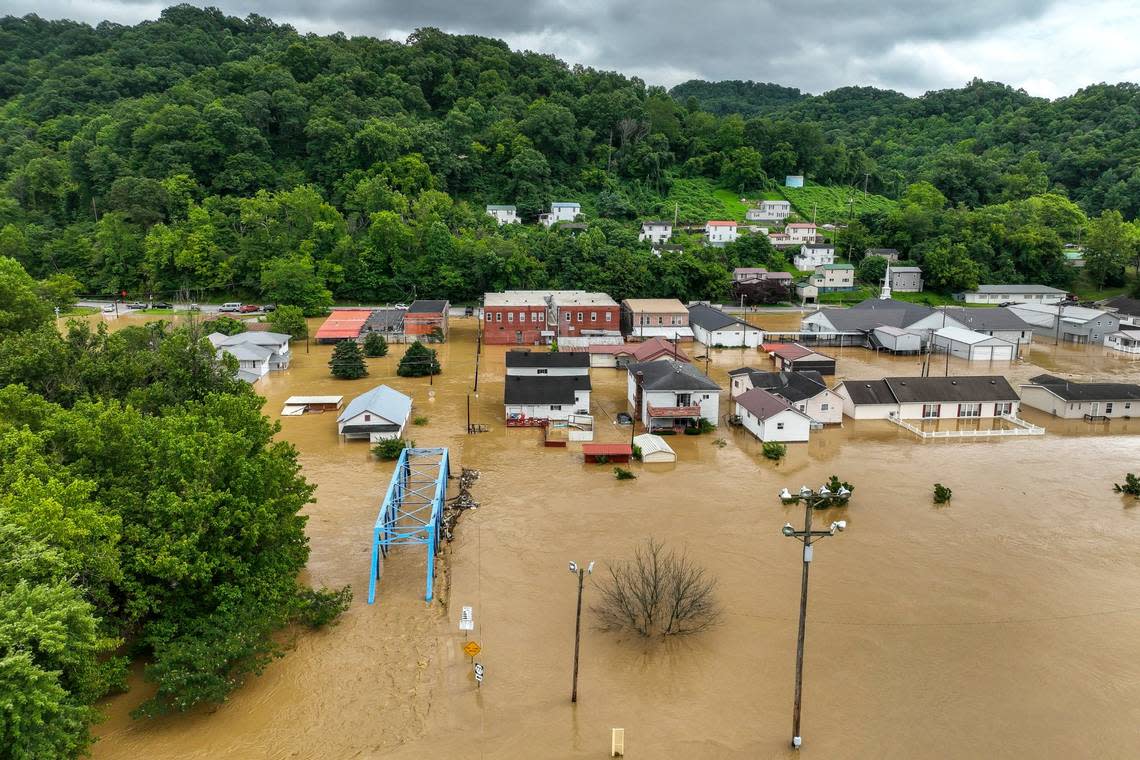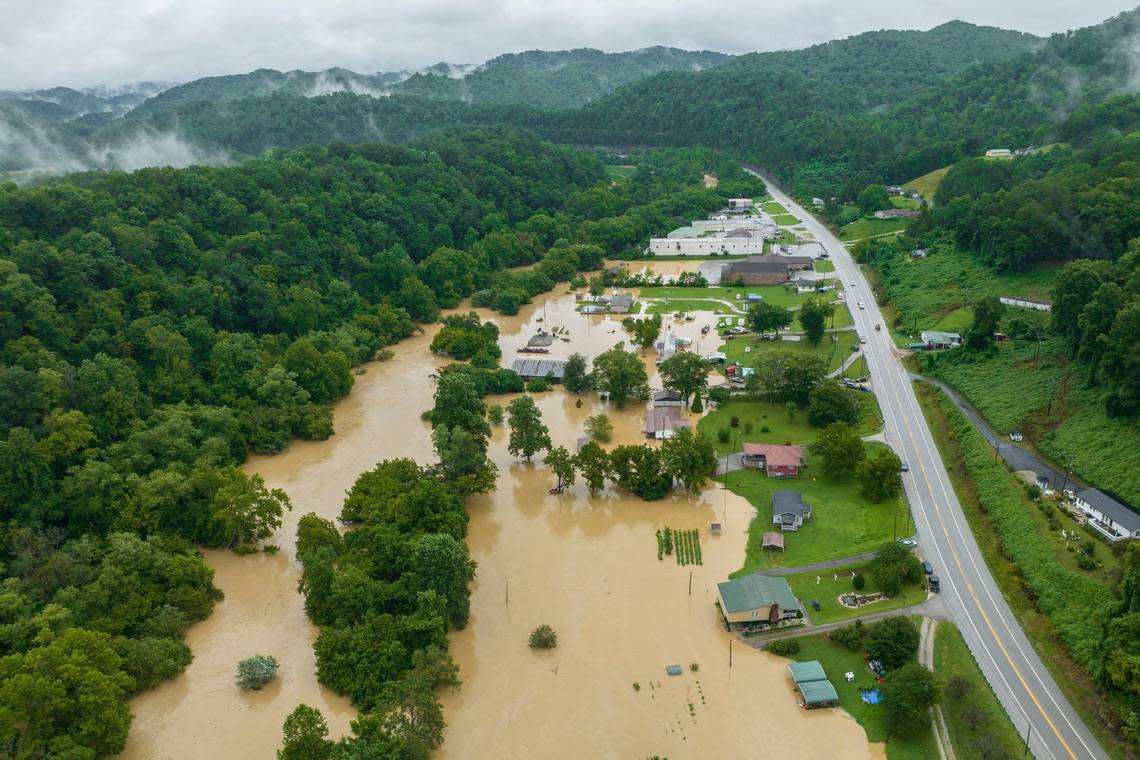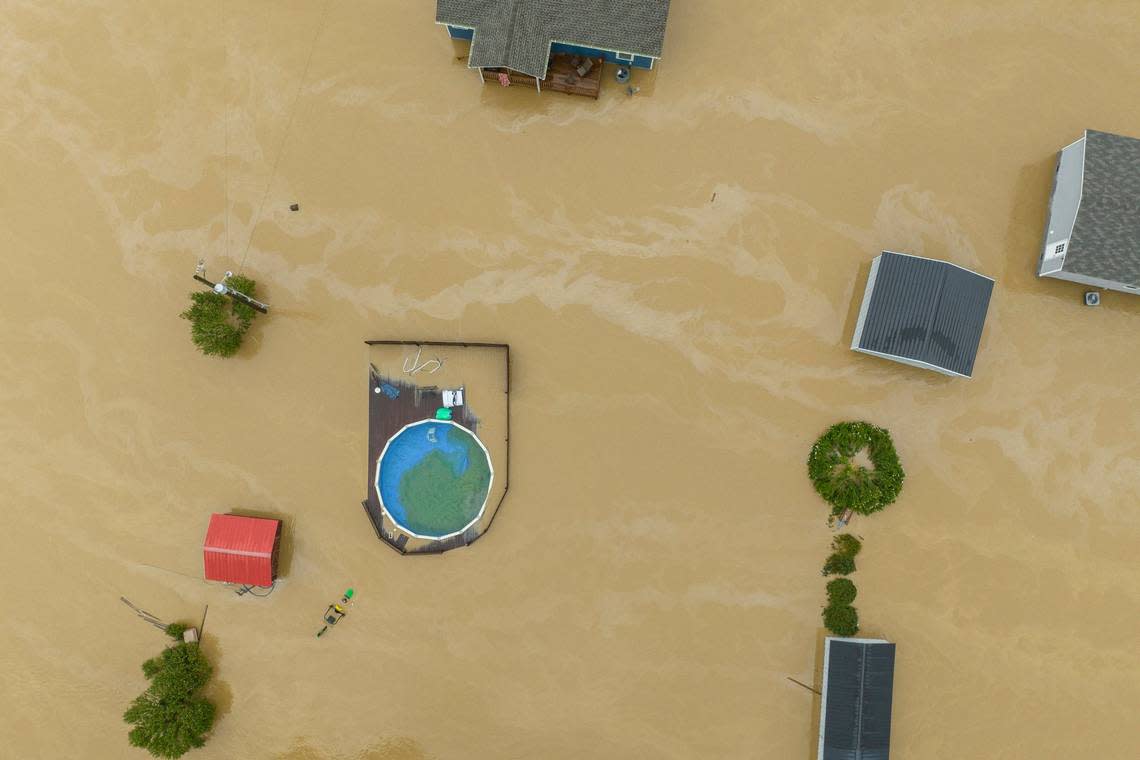Flooding devastates parts of Eastern Kentucky, leaving death and destruction in its wake
Six months after the last round of destruction, historic flooding once again consumed Eastern Kentucky on Thursday, taking at least eight lives, trapping others in homes and buildings, and sending thousands to shelters in what’s becoming a devastating and disturbingly common disaster scene in Kentucky’s Appalachian region.
Heavy flooding was reported in Breathitt, Floyd, Perry, Knott, Leslie, Pike and Magoffin counties.
By early Thursday, Gov. Andy Beshear had signed a state of emergency, calling the disaster “one of the worst, most devastating flooding events in Kentucky‘s history.” At a 9:30 a.m. presser he called the situation “dynamic,” and said that in most places the rising waters had not even crested yet. Beshear said that the administration expects loss of life to occur because of the flooding.
“What we’re going to see coming out of this is massive property damage. We expect the loss of life. Hundreds will lose their homes,” he said. “This is going to be yet another event that’s going to take not months, but likely years for many families to rebuild and recover from.”
Eight deaths from Kentucky floods
Eight deaths had been reported as of early Thursday evening, along with many who are missing.
One victim was an 82-year-old woman in Perry County, where fire departments were trying to rescue people from homes. According to Perry County Sheriff Joe Engle, one person drowned in the Chavies community of Perry County.
The death was reported around 10:48 a.m. Engle said the Kentucky Department of Fish and Wildlife were on the scene with the Perry County Coroner to investigate and remove the individual from the water.
With rain continuing to come down, the sheriff said “conditions are horrendous” to help rescue those who need help. “We are having a very difficult time getting to people,” Engle said. “Roads are blocked by trees, washed away completely or covered with water. It is now physically impossible to get to some people.”
Knott County Coroner Corey Watson confirmed that seven people were dead there. State police said Thursday night that four children were reported missing from Knott County.
It was unclear Thursday afternoon where the other deaths occurred.
Heavy rains had also knocked out power to more than 24,000 customers, according to a website that tracks power outages across the country.
The National Guard has also been activated in the region. National Guard Maj. Gen. Hal Lamberton said that the guard was activating rescue helicopters and vehicles able to drive through floodwaters. Beshear said National Guard personnel had rescued people from roofs and even from trees in Breathitt County. They will be joined by members of the West Virginia National Guard.
Three state parks are being opened to people in the region whose homes have been lost or damaged: Jenny Wiley, Buckhorn and Pine Mountain.
The National Weather Service said flooding on the North Fork of the Kentucky River at Whitesburg surged to a new record early Thursday, rising about 12 feet in 12 hours from 9 p.m. Wednesday to 9 a.m. Thursday. A weather service graphic showed the old record at the site at 14.7 feet. The river hit a high of 16.8 early Thursday.
The Kentucky Mesonet system, which has weather-monitoring stations statewide, said that as of 7 a.m. Thursday, 3.37 inches of rain had been recorded since midnight at a location in Breathitt County, with 2.7 inches in Pike County and 2.59 inches in Letcher County.


Scenes of devastation
In Letcher County, much of downtown Whitesburg was flooded.
Northeast of there in the town of Jenkins, Mayor Todd Depriest said the water came up quickly in and around town Thursday morning, preventing people from getting out.
At 10 a.m. Thursday, there were still people trapped in the upper floors of their houses in an area just outside the city, he said.
”I’ve never seen it do this,” said DePriest, who has lived in Jenkins for 54 years. “Been a rough one.”
Homes and businesses in the historic coal town had water in them Thursday. Water was flowing through a church — in the front door and out the back — across the street from City Hall, Depriest said. Power was out and the water and sewer-treatment plants in town were down.
Knott County High School and Buckhorn School in Perry County were surrounded by water. WKCB radio in Hindman was reporting a devastating scene, with highways looking like a river. Folks attending the Appalachian Writers Conference were also trapped in the Hindman Settlement School just outside of town. A social media report from the school said that everyone was safe, but several participants cars had been swept away.

In Breathitt County, the county courthouse opened its doors to those in need of temporary housing, according to Breathitt County Emergency Management. Several roads in the county are underwater and are impassable, per Breathitt County EMS.
Rowan County teacher Allison Slone said in a social media post, “Please pray for the people of eastern Kentucky. Our friends and family are losing everything. I’ve never seen flooding like I’m seeing in pictures. Complete devastation in some areas. People trapped. Homes flooding that have never flooded. People and homes being washed away.”
A worsening problem
Some communities are still recovering from massive floods in January and February. Flooding has become more frequent and more destructive, thanks to more severe weather caused by climate change, and the valleys and steep hills of Eastern Kentucky that make it more conducive to flash flooding. In March and February 2020, widespread flooding was recorded in 31 Kentucky counties, from Fayette to Martin. The state tallied more than $72 million in damage.
In an in-depth report on the problem in January, reporter Alex Acquisto noted: “The severity and frequency of flooding is unequivocally projected to worsen in the coming years as the climate continues warming, ultimately bringing more precipitation to vulnerable, unsupported terrain. Abandoned surface mines compound the land’s susceptibility for flooding and landslides. Compacted soil and treeless, tiered topography left by strip mines acts as a slippery surface and reduces land’s ability to absorb water. Lacking root systems that act as a natural guard against erosion, these steep slopes in some cases are more likely to give way, especially after heavy rainfall.”
Forecasters warned that more rain predicted for Thursday and Friday meant even more flooding through the weekend. At a later press conference, Beshear announced a Team Eastern Kentucky Flooding Relief Fund, similar to a fund the state set up in the wake of tornadoes in Western Kentucky last December.
